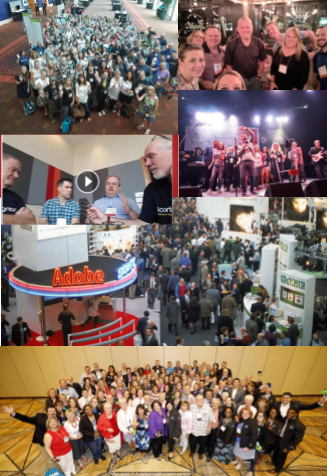Why Is #ISTESoWhite? #ISTE17

The International Society for Technology in Education (ISTE) conference provides a great platform to learn and connect with fellow educators...if you are white.
Like other tech conferences, ISTE lacked adequate representation of Blacks and Latinos in both attendees and presenters. Those present were not reflective of the public school students educators like me serve in places like New York City. My colleague JoJo Farrell who was attending his first ISTE, was also struck by the lack of diversity. It was particularly noticeable because of ISTE’s focus on being an International conference. As such it would stand to reason that those we saw at the conference would be representative of non-White communities tech educators are serving.
But, they are not.
Events in which I participated, noticed, and/or watched at ISTE.

Bronx school Principal Jamaal Bowman speculates that this could be due to the fact that often Black and Latino people don't know about these events. He also pointed out that chances are they have more pressing issues to think about like racism. Yet, we (white people) need their voices and insights. Jamaal thinks the problem is in part due to the fact that white people generally don’t grow up around people of color so many of the white people that have historically put these events together don't have Black and Latino friends and don't know how to approach them. They also may not notice when spaces are predominantly white.
A tale of two conferences
It is however, important to note, that this is my perspective. The perspective of a white person attending ISTE. The experience was not the same for everyone.
Rafranz Davis, a woman of color, who won the leadership award at #ISTE17, shared via Twitter that she and those in her circles did not have this experience. In fact, she said “this year the language used by both ISTE's CEO & board president was that of inclusivity & continued work. I speak for our entire community in saying this.” She added that, “We felt diversity this year.” She explained that they had a meetup of Black techs of color that was shared on social media. They have a private social media space where they planned and connected. They created their own safe spaces while encouraging each other as presenters and leaders. They felt this was a good year.
Tools and ideas to transform education. Sign up below.
This doesn’t come as a surprise. ISTE’s new board president, Dr. Mila Fuller is a woman of color who is addressing the issue of diversity head on. New board members (Gary Brantley, and S. Dallas Dance) are people of color who are also putting this issue at the forefront. Sarah Thomas, is another woman of color, standing out this year. She won the Making IT Happen award and had the opportunity to share her voice and insights during the keynote.
ISTE is intentionally working to make progress in this area. However, though there were more people of color in attendance this year, it is apparent that circles often did not connect. Change doesn’t happen overnight. There is still more work to be done to ensure not only that a diverse audience is present, but also that we make opportunities to connect and interact with one another.
That will only happen if we take notice and act to ensure that there is a diverse representation in the experiences, events, and work that we do. But it takes more than talk. As my colleague JoJo pointed out, what he has learned through years of being involved in activist causes, is that it shouldn’t just people people of color calling this out. White people need to call this out and take steps to change it as well. I agree and put together some ideas I had on actions in which we can take to invite diversity at ISTE and other conferences.
Strategies to invite diversity
1) Converse
Attendees can take note of whom they are engaging with in conversation. If everyone looks like you, change that. Your conversations will be richer and you will gain new insights.
2) Tweet
Share the ideas of your non-white colleagues by Tweeting their insights. Learn from and converse with your non-white colleagues by following, liking, and responding to them. Look at the people you follow and engage with on Twitter. If they are not diverse, be intentional about changing that.
3) Livestream
The livestreams I saw from the conference lacked diversity. Don’t do this. If you are livestreaming a conversation, be mindful to include non-white voices in the conversation.
4) Workshops
Invite/inspire your non-white colleagues to submit workshop proposals. Offer to help them or present with them if they are new to presenting and feel it would be helpful.
5) Panels
If you are organizing or participating on a panel, ensure it isn’t a bunch of white folks sharing their insights. If it is, address it and change it.
6) Keynotes
If there is not or historically there has not been a Black and/or Latino person delivering a keynote, ask why? Make recommendations on awesome voices to bring to the stage.
7) Empower staff
Supervisors can be mindful to ensure staff of color are attending conferences and exposed to what is taking place in the field. They can take it a step further and encourage them to submit proposals to show off the great work they are doing.
8) Invite
Conference organizers can be more intentional about how they get the word out about their event. Take the time to figure out how to reach out to a more diverse audience and help them feel welcomed. If you have local affiliates guide them in how to do the same.
I reached out to ISTE board members and advocates and discovered some of the actions they are taking to help ensure ISTE works to serve its diverse, international audience.
Actions taken by conference organizers and advocates
1) Digital Equity PLN (@DigEquityPLN)
ISTE DE PLN works to inspire thoughtful discussion & action aimed to ensure access & opportunities for all. Learn more at http://bit.ly/ISTEDEpln
2) New President, ISTE Board of Directors, Dr. Mila Fuller
This is an area of focus for new board President Mila Fuller. She is working to ensure that ISTE in-person attendees represent the diverse community that is active in technology in education online and in their own communities that are influenced by ISTE.
3) Black Techs of Color Meetup
This is a private social media space where Black techs of color planned and connected. They created their own safe spaces while encouraging each other as presenters and leaders.
4) Support from The #ISTEBoard
The ISTE Board believes in the need for an inclusive network and they are taking actions to move in that direction. They acknowledge the issue and are addressing this by ensuring their marketing materials, presenters, and student standards (such as #7 Global Collaborator) are more inclusive.
These are some ideas that conference organizers and attendees can do to bring a more diverse representation of voices to the places where we connect, share, and spread ideas. It is important to note that, while I have noticed and am bringing up this issue, I am no expert. I squarely stand in the shoes of a learner. I'd love to know what you think? Are there some ideas that would work for you? What are some ideas that you would like to see happening? What's missing?
Lisa Nielsen writes for and speaks to audiences across the globe about learning innovatively and is frequently covered by local and national media for her views on “Passion (not data) Driven Learning,” "Thinking Outside the Ban" to harness the power of technology for learning, and using the power of social media to provide a voice to educators and students. Ms. Nielsen has worked for more than a decade in various capacities to support learning in real and innovative ways that will prepare students for success. In addition to her award-winning blog, The Innovative Educator, Ms. Nielsen’s writing is featured in places such as Huffington Post, Tech & Learning, ISTE Connects, ASCD Wholechild, MindShift, Leading & Learning, The Unplugged Mom, and is the author the book Teaching Generation Text.
Disclaimer: The information shared here is strictly that of the author and does not reflect the opinions or endorsement of her employer.
Lisa Nielsen (@InnovativeEdu) has worked as a public-school educator and administrator since 1997. She is a prolific writer best known for her award-winning blog, The Innovative Educator. Nielsen is the author of several books and her writing has been featured in media outlets such as The New York Times, The Wall Street Journal, and Tech & Learning.
Disclaimer: The information shared here is strictly that of the author and does not reflect the opinions or endorsement of her employer.
